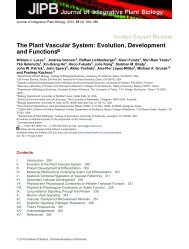New species of Solanum and Capsicum (Solanaceae) from Bolivia ...
New species of Solanum and Capsicum (Solanaceae) from Bolivia ...
New species of Solanum and Capsicum (Solanaceae) from Bolivia ...
You also want an ePaper? Increase the reach of your titles
YUMPU automatically turns print PDFs into web optimized ePapers that Google loves.
2006] nee et al.: solanum <strong>and</strong> capsicum (solanaceae) 343<br />
ermes, racemosae; calyx 3 mm longus, fere truncatus;<br />
corolla eburnea, pr<strong>of</strong>unde lobata, lobis linearilanceolatis,<br />
12–20 × 2–2.5 mm; antherae attenuatae, 11–<br />
12 × 1.5 mm, vel nonnunquam 6–7.5 mm longae. Baccae<br />
nitidae, aurantiacae vel rubrae, 1.5–2 cm diametro;<br />
semina complanata, reniformia, 3.4–3.7 × 2.8–3.2 mm.<br />
Scrambling vine; stem closely tomentose<br />
with ferruginous sessile (or nearly) 7–8rayed<br />
stellae, 0.4 mm wide, with obsolete<br />
midpoints, eventually glabrescent, armed<br />
with uniform small recurved prickles 1.5–3<br />
mm long <strong>from</strong> enlarged flattened bases. Sympodial<br />
units unifoliate or usually difoliate,<br />
rarely 3-foliate, geminate. Leaves 5–18 ×<br />
1.3–6.5 cm, simple, dimorphic or not, the<br />
major leaves 10–18 × 2.5–6.5 cm, narrowly<br />
elliptic, the minor leaves 5–18 × 1.3–6.5 cm,<br />
differing <strong>from</strong> the major ones only in size,<br />
thin-textured, sparsely to densely tomentose<br />
adaxially with sessile 4–8-rayed stellae 0.3–<br />
0.5 mm wide, the midpoints absent to 1.5<br />
mm long, the trichomes not obscuring the<br />
surface, tomentose abaxially with sessile or<br />
very short-stipitate stellae 0.6–0.7 mm wide,<br />
somewhat larger than those above but with<br />
obsolete midpoints, the surface visible, the<br />
leaf undersides with recurved prickles on the<br />
midrib similar to those <strong>of</strong> the stem; base unequal<br />
(oblique); margin entire or very shallowly<br />
angulate-lobed; apex acute to attenuate;<br />
petioles 0.8–2.5 cm, armed with hairs<br />
<strong>and</strong> recurved prickles like those <strong>of</strong> the stem.<br />
Inflorescence 3–5.5 cm, extra-axillary, unbranched,<br />
with 5–15 flowers, all flowers apparently<br />
perfect, the axes stellate-tomentose,<br />
unarmed; peduncle 0.8–1.1 cm; rachis 2.5–<br />
4.5 cm; pedicels 8–9 mm in flower, 16–20<br />
mm in fruit, thick <strong>and</strong> enlarged at the apex,<br />
slightly curved, spaced 1–1.5 mm apart, articulated<br />
at the base. Calyx ca. 3 mm long,<br />
the tube ca. 2.5–3 mm, the margin almost<br />
truncate <strong>and</strong> lobes nearly absent, with an<br />
apicular extension <strong>of</strong> the midrib up to 1 mm<br />
long, stellate-tomentose abaxially, glabrous<br />
adaxially; fruiting calyx accrescent, to ca. 6<br />
mm long, splitting nearly to the base, eventually<br />
breaking <strong>of</strong>f irregularly, the remaining<br />
calyx tube flattened <strong>and</strong> somewhat woody;<br />
corolla 2.5–5 cm in diameter, 18–20 mm<br />
long, stellate, attenuate <strong>and</strong> slightly curved in<br />
bud, creamy white, the tube 2 mm, the lobes<br />
12–20 × 2–2.5 mm, linear-lanceolate, tomentose<br />
abaxially with weak whitish stellae,<br />
glabrous adaxially; filaments obsolete; anthers<br />
(6–) 11–12 × 1.5 mm, very slender, attenuate,<br />
not connivent, yellow, the pores<br />
minute <strong>and</strong> directed distally, not opening into<br />
longitudinal slits with age; ovary sparsely tomentose<br />
at apex, glabrescent; style ca. 12 ×<br />
0.3–0.4 mm, exceeding the anthers by about<br />
1.5 mm, clavate, straight to slightly curved,<br />
stellate-tomentose near the base; stigma truncate<br />
to capitate. Fruit a globose berry, 1.5–2<br />
cm in diameter, shiny bright orange or red,<br />
glabrous. Seeds numerous (more than 15 per<br />
fruit), 3.4–3.7 × 2.8–3.2 mm, flattened, reniform,<br />
light brown or yellowish, the surfaces<br />
minutely pitted.<br />
Distribution <strong>and</strong> ecology.—Humid evergreen<br />
forests <strong>of</strong> the Amazon basin near the<br />
eastern base <strong>of</strong> the Andes <strong>from</strong> Colombia to<br />
the southern limit <strong>of</strong> the tropical forest just<br />
northwest <strong>of</strong> the city <strong>of</strong> Santa Cruz, <strong>Bolivia</strong>,<br />
also more rarely on the western Andean<br />
slopes in Ecuador, at 90–1800 m elevation.<br />
Phenology.—Flowering <strong>and</strong> fruiting all<br />
year.<br />
Etymology.—The epithet reflects the distribution<br />
along the piedmont, the lower eastern<br />
slopes <strong>of</strong> the Andes <strong>and</strong> immediately adjacent<br />
Amazon lowl<strong>and</strong>s, <strong>and</strong> the western Andean<br />
slopes in Ecuador.<br />
Common names.—Ecuador: “cocona del<br />
monte” (Lawesson et al. 39532B); Peru:<br />
“ayac mulláca” (bitter fruit, Mexia 6485),<br />
“chirapahuasca” (Schunke 77).<br />
Uses.—The seeds are said to be used for<br />
“skin spots; caustic” (Mexia 6485).<br />
Additional specimens examined. COLOMBIA.<br />
Amazonas: Municipio Leticia, Parque Nacional Natural<br />
Amacayacu, sector de Mata-matá, a la orilla de la quebrada<br />
Bacaba, 3°47'S, 70°15'W, 100 m, 16 Apr 1992 (fr),<br />
Rudas & Prieto 4278 (BM); Municipio Leticia, brazo<br />
del Río Amazonas, lado de la estación principal del Parque<br />
Nacional Natural Amacayacu, 14 Jun 1992 (fl),<br />
Rueda 556 (BM); Loretoyacu River, 100 m, Mar 1946<br />
(fr), Schultes 7130 (GH).<br />
ECUADOR. Esmeraldas: San José, km. 321 along<br />
railroad <strong>from</strong> Ibarra to San Lorenzo, 1°N, 78°W, 350 m,<br />
4 May 1982 (fr), Boom 1364 (MO); Cantón San<br />
Lorenzo, Reserva Indígena Awá, Cañon del Río Mira, 10<br />
km W de Alto Tambo, Comunidad “La Unión”, 1°02'N,<br />
78°26'W, 250 m, 16–26 Mar 1991 (fr), Rubio et al. 1112<br />
(NY). Morona-Santiago: Pozo petrolero “Garza” de<br />
TENNECO, 35 km NE de Montalvo, 1°49'S, 76°42'W,<br />
260 m, 2–12 Jul 1989 (fr), Zak & Espinoza 4376 (MO,<br />
NY), 4448 (BM, MO, NY). Napo: Yasuní Forest Reserve,<br />
1–3 km E <strong>of</strong> Pontificia Universidad Católica de<br />
Ecuador Science Station, by Tiputini River, 0°40.8'S,
















